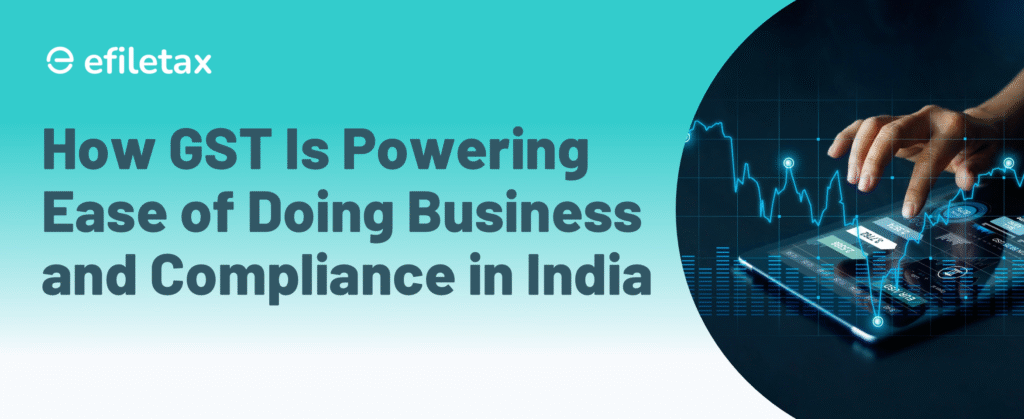
GST and Ease of Doing Business: Compliance Made Simpler
India’s Goods and Services Tax (GST) has significantly reshaped the business compliance landscape. Introduced in 2017, GST was built on a bold vision: ease of doing business through simplified, tech-driven indirect taxation.
In this blog, we break down how GST continues to promote business ease and ensure better compliance in 2025, backed by recent reforms, CBIC circulars, and expert insights.
How GST Promotes Ease of Doing Business
The GST Council and CBIC have consistently aimed to reduce the compliance burden while expanding the tax base. Here’s how:
Uniform Tax Structure
- Eliminated cascading effect of multiple state and central taxes
- One nation, one tax system for businesses across India
- Reduced tax confusion for MSMEs and startups
Online Registration and Filing
- Single GSTIN for PAN-linked business entities
- Fully digital filing of GSTR-1, GSTR-3B, IFF, etc.
- Auto-populated returns via GSTR-2B and GSTR-1A help reduce errors
Input Tax Credit (ITC) System
- Transparent claim process linked to invoice uploads
- Rule 36(4) and GSTR-2B matching reduce fake ITC claims
- Ensures genuine suppliers and better working capital for buyers
Quarterly Filing Option for Small Taxpayers
- Under QRMP scheme:
- File GSTR-1 and GSTR-3B quarterly
- Pay tax monthly using fixed sum or self-assessment
- Ideal for businesses with turnover up to ₹5 crore
Amnesty and Rationalisation Measures
- 53rd GST Council Meeting (22 June 2024) proposed:
- Waiver of late fees for GSTR-4, GSTR-9
- Decriminalisation of certain offences under Section 132
- Reduction in interest rates for delayed payments
- These improve voluntary compliance and help dormant businesses revive
Legal References that Back GST Reforms
- Section 122–132: Penalty and offence structure revised to decriminalise minor lapses
- Rule 88C & 88D: Auto-intimations for tax mismatches, reducing audit notices
- Notification No. 14/2022-CT & 26/2022-CT: Expanded e-invoicing to improve tracking and curb evasion
Expert View: Practical Tip for Small Businesses
“If your turnover is below ₹5 crore, opt for the QRMP scheme and use the Invoice Furnishing Facility (IFF). It reduces your filing burden without missing out on ITC benefits to buyers.”
— Efiletax GST Expert Panel
Comparison Table: Before GST vs After GST
| Feature | Pre-GST Era | Post-GST (2025) |
|---|---|---|
| Number of Taxes | Excise, VAT, CST, Service Tax | One consolidated GST |
| Return Filing | Separate for each law | Single portal (GSTN) |
| Registration Process | State-wise, physical | PAN-based, online |
| Input Credit System | Limited, complex | Seamless, invoice-linked |
| Tax Audits | Manual, frequent | Risk-based AI selection |
Recent Stats: Impact of GST on Business Compliance
As per PIB Press Release (June 2025):
- Monthly GST collections crossed ₹1.85 lakh crore for 8 consecutive months
- Over 1.5 crore taxpayers now file returns without assistance
- 30% increase in voluntary compliance post QRMP simplification
Source: https://pib.gov.in/PressReleasePage.aspx
Ongoing Reforms for Even Better Compliance
- New GST Appellate Tribunal (GSTAT) framework under Sections 109–111
- Digital dashboards and redressal portals by CBIC
- AI-based alerts for mismatch resolution (Rule 88C/D implementation in FY 2024–25)
- E-invoicing now mandatory for businesses above ₹5 crore
FAQ Section
Q1. Does GST increase the compliance burden for small businesses?
No. With schemes like QRMP, small taxpayers file fewer returns while remaining compliant.
Q2. Can I avoid GSTR-9 late fees?
Yes. As per the 53rd Council Meet, amnesty is available for certain past returns.
Q3. Is GST applicable even if I supply services from home?
Yes, if your aggregate turnover exceeds ₹20 lakh (₹10 lakh in some states).
Summary
GST and ease of doing business go hand in hand. From simplified return filing to the QRMP scheme, GST reforms have made tax compliance easier for Indian businesses.
Need Help with GST Filing?
Let Efiletax handle your GST returns, ITC reconciliation, and compliance.